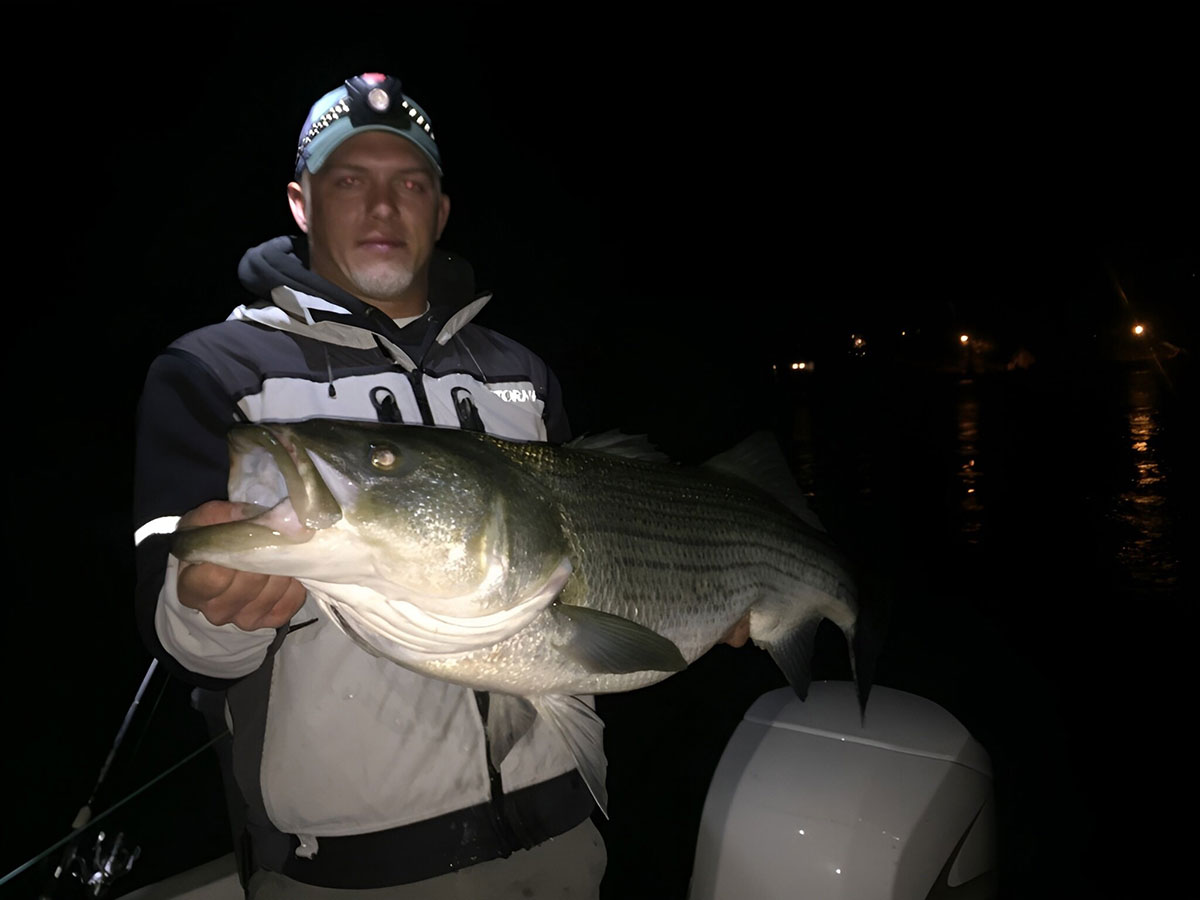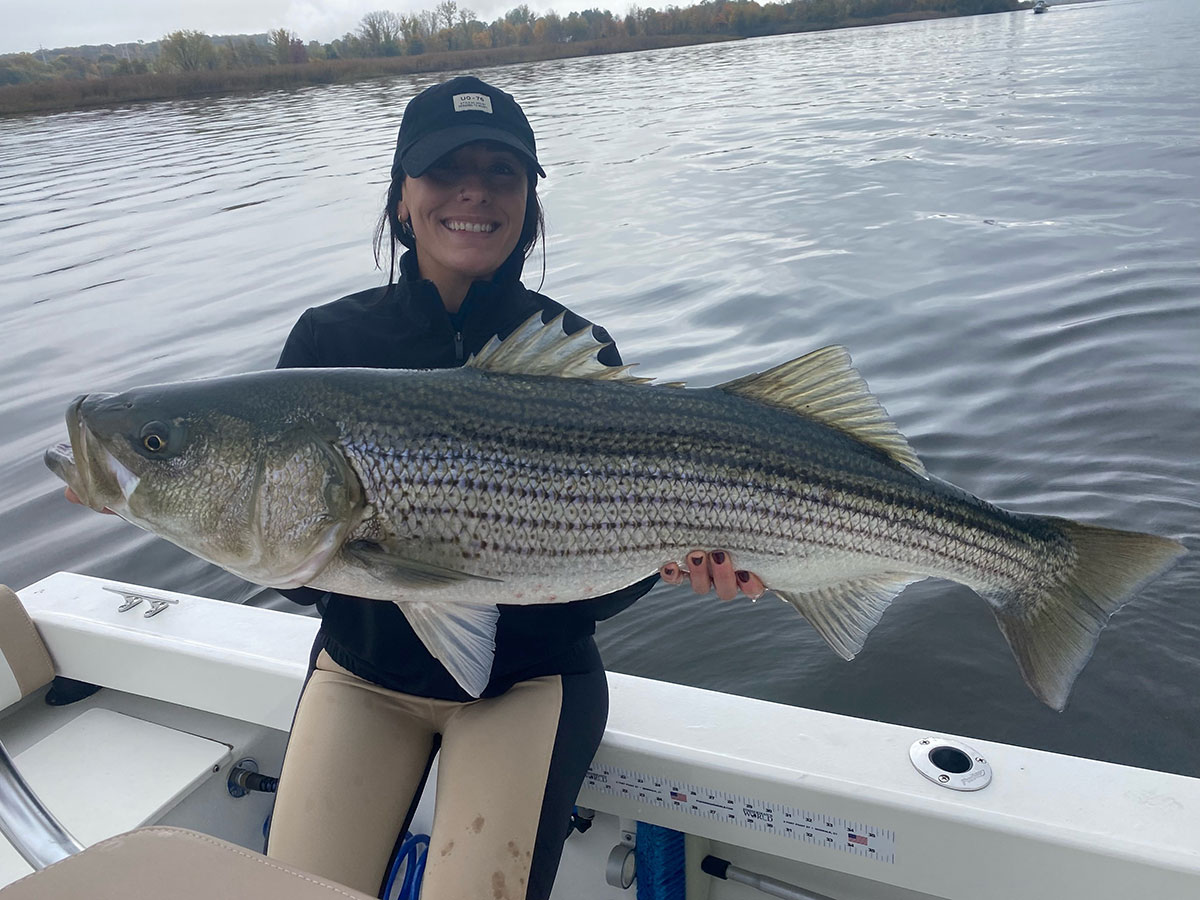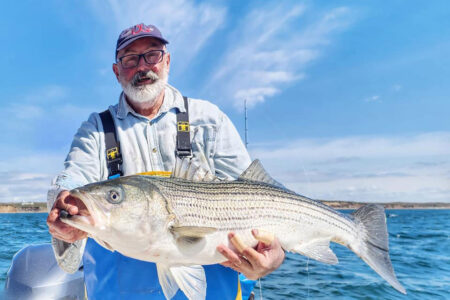
It’s no secret that the tidal section of the Housatonic River is one of the hottest wintertime striped bass fisheries in the Northeast. People travel from all over New England and even Pennsylvania, New York and New Jersey to put a bend in the rod through the winter months. The river fills with freshwater bass boats by day and the shoreline glitters with hundreds of headlamps after dark. The Housy holds an abundance of schoolie bass but if you fish it enough, you know about the 20- to 40-pound fish that can be found lurking with the schoolies, it takes dedication and lots of time to hook the biggest ones.
The Housatonic River runs almost 150 miles from the Berkshires up in Massachusetts to Long Island Sound; but it’s the last seven miles that striper diehards should concentrate on through the winter. From Derby Dam down to the mouth, thousands upon thousands of striped bass will take up winter residence here and can be caught, even during the coldest months. There’s a definite progression as far as how the fish move within the river throughout the season.

Seasonal Progression
While this is thought of as a winter fishery, the bite really begins in late-October. At this time the fish can be found throughout the entire tidal stretch – from the mouth to Derby Dam. Striped bass often pin bunker and shad up against the dam and some amazing topwater fishing happens there. Hungry bass continue to flood into the river through November, but as water temps continue to fall, the adult and peanut bunker begin running down and out of the river, this is when the stripers really start packing on the winter weight. Fishing from the 95 bridge to the mouth can be fantastic from Thanksgiving to Christmas, especially if we get a good run of Atlantic herring. Some of my biggest late season bass are caught this time of year live-lining herring or throwing big soft plastics on lead heads, Lunker City’s 10-inch Fin-S Fish is one my favorites.
While a lot of the smaller fish flood the upper part of the river, the bigger fish will hang down closer to the mouth and chow on herring before making their last move upriver where they will remain through the winter months. By the time we cross into the New Year, pretty much all Housy anglers are up river by land and boat. There are hot spots from shore such as the Shelton Sports Complex, Sunny Side School and O’Sullivans Island. These spots are located in Shelton and Derby, they offer easy access and there is legal parking nearby. The new state boat ramp located in Milford will be full – almost daily – with SUVs, trucks and empty trailers. The fish will stay in this upper portion of the river, pretty much from the Sportsplex up to O’Sullivan’s Island, through January, February and most of March, when warming waters and the start of the herring run will encourage the stripers to move around a little more.

Get Into Gear
I fish the river from a boat nowadays and pull it from the slip the first week of January, however I have done my fair share of shore fishing in the river over the years as well. By boat, I always have a couple different rods with me rated for different tasks. I like to use a 7- to 7.5-foot medium heavy rod rated up to 1.5 ounces and a medium rod rated up to 3/4-ounce. The heavier of the rods is my go-to choice when fishing an outgoing tide. When the tide is dropping, the current in the river can really get moving and you’ll be happy you have the extra backbone when you hook a 35-pound holdover in that current! During slower periods of the tide, or when I’m fishing incoming water, that’s when the lighter rod comes into play. With the slower water, you can use lighter jigs and feel the subtle bites.
For the reels, I’ll typically use a 4000 to 6000 size reel spooled with 20- to 30-pound braid on the heavier stick, I want to maximize the stopping power with this setup for that heavier current. One the lighter rig, I’ll use a 3000 to 4000 size reel, spooled with 15-pound braided line. I like that super-light braid because it cuts through the current, allowing me to fish lighter jigs and feel subtler bites.
Some rods I would recommend on the high end side would be G Loomis’s IMX Pro Blue series, St. Croix’s Legend and Avid series and Shimano’s Teramar XX Northeast rods. For reels, I like Shimano’s Stella and Twin Power XD and Daiwa’s Certate SW and their Saltist MQ. I work at Fisherman’s World in Norwalk, CT so I have a lot of gear, you don’t have to have the highest-end gear for this fishery. Rods from the St. Croix Triumph or Mojo lines and Daiwa’s Back Bay Series are very popular. And for reels that are a little easier on the wallet, try the Shimano Stradic, Daiwa BG or the Penn Battle DX, these reels are all workhorses with a proved track record of the river.
While fishing from shore, an 8- or 9-foot rod is best, paired with a 5000 or 6000 series reel or Van Staal’s VS and VR series in the 125 or 150 size. Salmon rods in this same size bracket have grown popular over the years; St. Croix and G. Loomis offer a variety of price points and options within this category. When it comes to surf rods, St. Croix, Shimano, ODM, Daiwa, Black Hole and many other companies offer great options for winter bass. I like St. Croix’s Legend and Avid and Black Hole’s Striper Special surf rod, as well as their Suzuki Special. The ODM Genesis and D.N.A. series are also popular rods along the banks of the Housy. Basically, you need to hit a local shop and see which of the many options listed are a good fit for your fishing style; there’s no online replacement for getting the feel for a rod before you buy it.
Plugs & Plastics
For lures, the winter fishery consists of mostly soft plastics on lead heads and sinking SP Minnows. There are tons of plastics in the market nowadays. My favorites are Lunker City’s Fin-S Fish and Slug-Go’s in various sizes, but I really like the larger baits in December, along with Gravity Tackle’s GT Eels and paddletails. Some other popular plastics are NLBN and Albie Snax both of which have grown very popular over the last couple of years. When it comes to choosing your leadhead, the first thing I look for is a quality hook. No one likes reeling in a bent-out hook and the only thing worse than that is that sick feeling you get when you lose a big fish. Z man’s TT Jighead, Lunker City’s Titan series and Gravity Tackle’s Atlas jigheads all offer quality hooks and a variety of weights and hook sizes. For a leader, you can choose from many companies such as Seaguar, Yo-Zuri, Ande, Tsunami and many others. It’s a good idea to carry a couple different line classes; I generally keep 15- to 30-pound test with me. Lighter leader comes into play when the water is clear and the fish have a “lockjaw.”

Staying Safe
The water is cold and the decks are slippery. The river can be a dangerous place for new boaters or even the seasoned old salt that’s been running up and down the river for years. There are many shallow spots to be aware of and it’s not uncommon to find debris floating down the river. When night falls, you don’t see nearly as many boats as by day. It’s dark and the Housy is a pretty tight area to navigate. I’ve seen trees and barrels floating in the tide and I’ve clipped more logs than I’d care to admit. When it comes to safety equipment on the boat, I always have life jackets for everyone, a 50-foot throw bag and a handheld spotlight that I use to scan the water in front while underway, looking for debris in the river. Flares, air horns and a medical kit should always be onboard as well. Functioning navigation lights should always be on. Too often I have seen smaller boats with no navigation lights and they’re putting themselves and other boaters in danger during low-light conditions. And for the sake of comfort, always bring hand warmers and at least one pair of extra gloves in case one gets wet.
For anglers fishing from shore at night that want to wade in the river, a quality pair of waders such as Reddington’s Sonic Pro and Simms Freestone and Tributary series work great this time of year. These companies also offer wading boots. Using Korkers or aftermarket studs screwed into the soles of your boots is a smart move. The rocks are slippery and the banks are steep and you really don’t want to take a night swim at this time of year! For tops, I recommend Stormr’s Stryker or Typhoon series; these jackets are neoprene, waterproof and insulated. They provide positive buoyancy which will help if you slip into the cold water and they’re warm and comfortable. A surf belt on the outside of your jacket will increase your safety, a head lamp and a knife on your belt is a must. If you get swept in and your waders fill up, you will be happy to have that knife on you, so you can cut your waders and let that heavy water out.
The Housy offers a unique winter striped bass fishery that puts out some really nice fish every year. If you go during the day you can go for numbers and fish over vast schools of small to medium stripers—many anglers report 40 to 100 fish days when the bite is on. After dark, the bigger fish become more active, and while the bite is not always on fire, if you put your time in (and fish some larger baits) you could tangle with a winter 30-pounder or even larger. Check it out this winter, chances are, you’ll be back.




